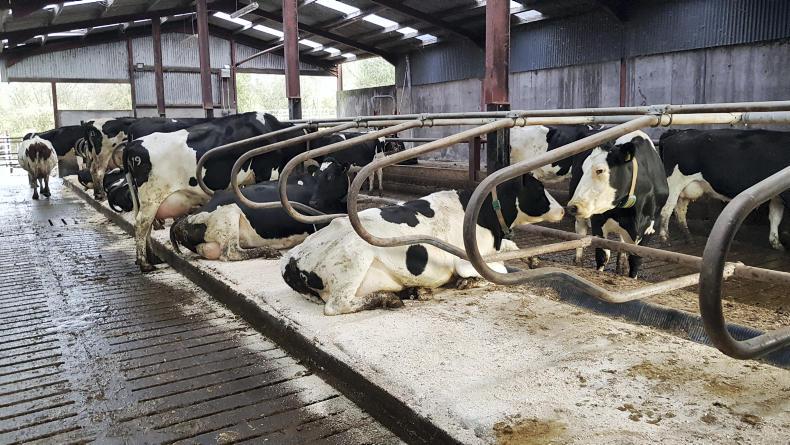With meal prices up significantly on 2017 levels, dairy farmers are particularly conscious this year that concentrates need to be targeted at cows that will deliver in terms of production.
Grouping cows according to stage of lactation and yield or using automatic feed-to-yield systems can allow efficient concentrate feeding. Conducting silage analysis and basing concentrate levels on silage quality is also key to efficient feeding.
Dairylink adviser Conail Keown states that late-lactation cows will not respond in terms of yield to high levels of concentrates. For farmers with stale cows in low body condition, his advice is to dry them off a few weeks early.
In the case of John Oliver, his herd is calving in a tight profile, so almost all milking cows are at the same early stage of lactation.
This means he can set his in-parlour feeders to a high flat-rate level to lead-feed cows for the first 100 days or so. This front-loading of concentrates is working in terms of milk production and will help winter bonus payments.
Phase one farmers who developed and maintained compact calving blocks state that it allows more uniform feeding regimes, improves overall herd fertility and brings labour-saving benefits, with heifer rearing.
Key to getting cows calving down in a tight profile is getting them served in a short time frame. With breeding under way on most Dairylink farms, the weekly production table at the bottom of this page will contain two new benchmarks on the proportion of cows and heifers served.
The figures are set against the proportion of cows and heifers that are deemed eligible for service by each farmer. On most farms, eligible cows are past the usual voluntary waiting period of 42 days, although some farmers serve cows before this.
Weekly roundup
Breeding started on John Oliver’s farm near Limavady last Monday (19 November). By Tuesday, there were 24 cows and 19 heifers served, which equates to 44% of eligible cows and heifers.
Heats are detected in the milking herd with movement sensor collars and the AI contractor visits once a day after morning milking.
John plans to go through heat records at the end of the week and pick out any cows that are over six weeks in milk and have not recorded a heat. These cows will be examined by a vet before treatments are given to individual cows.
Heifers are observed visually for heats and stickers are used as an aid. The original plan was to put heifers on a prostaglandin-based synchronisation programme in the first cycle, but this has been shelved, as heifers came on heat quicker and were easier to detect than expected.
Heifers are housed across the yard from the main cubicle house and parlour, so observing heats is not a major inconvenience for John.
Calving
There are 73 cows calved so far this year and four stale cows are still milking. In total, there are 19 cows and four heifers left to calve on John’s farm.
Calving started in early September and 66% of the herd calved down in the first six weeks. The oldest calves have been weaned off milk replacer and are on straw and a calf weaner pellet ad-lib.
Cows are fed silage in blocks and there is no diet feeder on the farm. The milking herd is on first-cut silage at present and were initially fed good-quality bales made from surplus grazing grass.
John said that he calculated that first cut would last 10 to 12 weeks and he delayed opening the pit so that cows would not be moving off first cut until most of the herd are served and settled in-calf. Last year, first cut was used up by mid-December and the change in diet was blamed for a few cows repeating shortly after.
Silage analysis
John’s first-cut silage is average- to good-quality, with samples analysing at a metabolisable energy of 11.2MJ/kg DM, crude protein of 11.4%, D-value of 69.9% and dry matter of 24.8%.
Cows are producing around seven litres from forage at present, with the herd yielding 29 litres/cow/day on average.
Cows are on an 18% crude protein nut and average feed rate is currently 10kg/cow/day through in-parlour and out-of-parlour feeders.
Parlour feeders are set to give a flat rate of 7kg/cow/day and out-of-parlour feeders top cows up at a rate of 0.45kg/litre above 23 litres.
This means a cow yielding 35 litres will get 7kg in the parlour and 5.4kg in the out-of-parlour feeder over a 24-hour period.
John can maintain a high level for flat-rate feeding in the parlour as he has a compact profile, meaning almost all his cows are at the same stage in early lactation and will respond well to concentrates.
